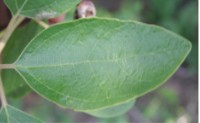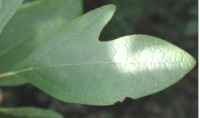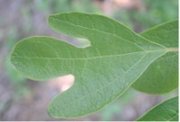Sassafras
|
|
- This page is about the Sassafras tree. Sassafras, Victoria is a suburb of Melbourne, Victoria, Australia.
| Sassafras | ||||||||||||
|---|---|---|---|---|---|---|---|---|---|---|---|---|
 Sassafras albidum flowers, Hemingway, South Carolina | ||||||||||||
| Scientific classification | ||||||||||||
| ||||||||||||
| Species | ||||||||||||
Sassafras is a genus of three species of deciduous trees in the family Lauraceae, native to eastern North America and eastern Asia.
Sassafras trees grows from 15-35 m tall and 70-150 cm diameter, with many slender branches, and smooth, orange-brown bark. The branching is sympodial. The bark of the mature trunk is thick, red-brown, and deeply furrowed. The wood is light, soft, weak, and brittle. All parts of the plants are very fragrant.
The species are unusual in having three distinct leaf patterns on the same plant; unlobed oval, bilobed (mitten-shaped), and trilobed (three pronged). They have smooth margins and grow 7-20 cm long by 5-10 cm broad. The young leaves and twigs are quite mucilaginous. The tiny, yellow flowers are five-petaled and bloom in the spring; they are dioecious, with male and female flowers on separate trees. The fruit are blue-black, egg-shaped, 1 cm long, produced on long, red-stalked cups, and mature in late summer.
The name "Sassafras", applied by the Spanish botanist Monardes in the sixteenth century, is said to be a corruption of the Spanish word for saxifrage.
Species
- Sassafras albidum (Nuttall) Nees - Sassafras, White Sassafras, Red Sassafras or Silky Sassafras. Eastern North America, from southernmost Ontario, Canada through the eastern United States south to central Florida, and west to southern Iowa and eastern Texas.
- Sassafras randaiense (Hayata) Rehd. - Taiwan Sassafras. Taiwan.
- Sassafras tzumu (Hemsl.) Hemsl. - Chinese Sassafras or Tzumu. Central and southwestern China. It differs from S. albidum in the leaves being more frequently three-lobed, the lobes having an tapered acuminate apex (not rounded to weakly acute).
Uses
A toxic oil, safrole, distilled from the root-bark or the fruit is used as a fragrance in perfumes and soaps. The root or root bark is also used to make tea. A yellow dye is obtained from the wood. The shoots are used to make root beer (formerly alcoholic, but now a soft drink), which owes its characteristic odor to the sassafras extract. The leaves are used for thickening sauces and soups, and when dried and ground are known as filé powder, a spice used in Cajun, Creole, and other Louisiana cooking, such as the dish gumbo filé. The pith is used in the US to soothe eye inflammation and ease catarrh. Although sassafras can serve many useful purposes, safrole is now recognized by the USDA as a carcinogen. Sassafras essential oil is also the preferred source of safrole for MDMA production by clandestine laboratories, thus its sale is monitored by the DEA.
The aromatic oil that is used for flavoring candies and tea comes from the bark of the roots. The smell of this oil is said to make an excellent repellant for mosquitoes and other insects, which makes it a nice yard plant.
External links
- Flora of North America: Sassafras albidum (http://www.efloras.org/florataxon.aspx?flora_id=1&taxon_id=233501217)
- Sassafras (http://www.wildmanstevebrill.com/Plants.Folder/Sassafras.html)
- Ohio State Univ. Extension: Ohio trees (http://ohioline.osu.edu/b700/b700_37.html)
- Arboretum Trompenburg: Sassafras tzumu photo (http://www.esveld.nl/plantdias/51/51682.jpg)
- Plant Image Gallery - Sassafras (http://www.noble.org/imagegallery/woodhtml/Sassafras.html)
- Botanical.com, A Modern Herbal (http://www.botanical.com/botanical/mgmh/s/sassaf20.html)



